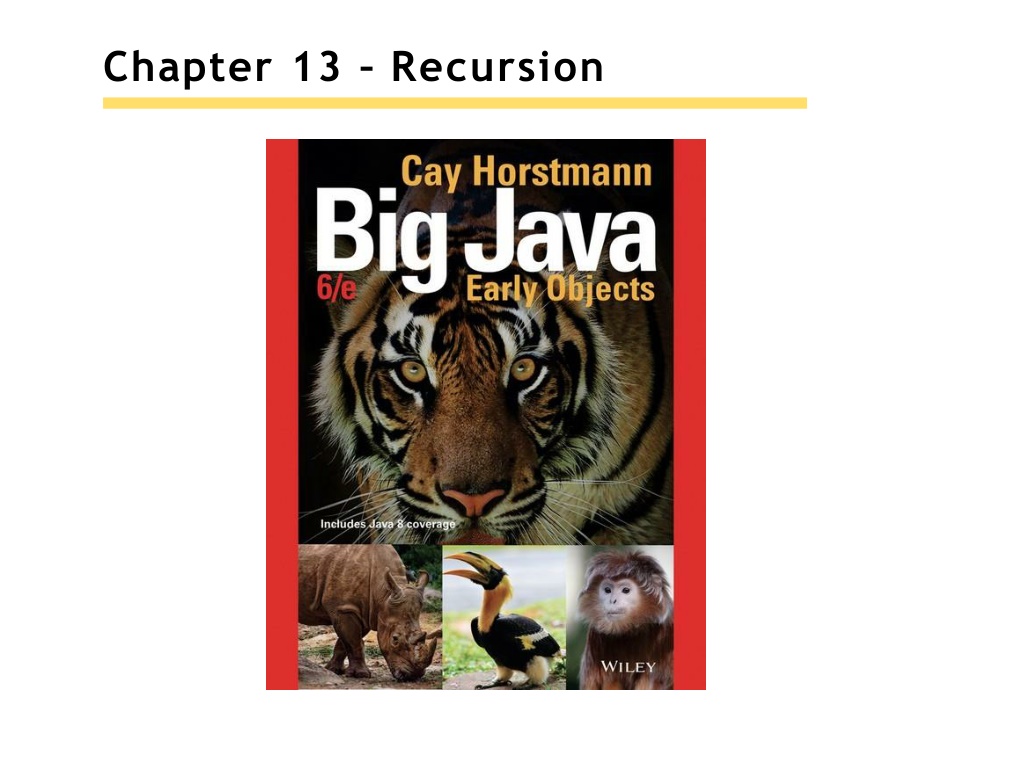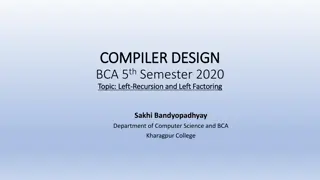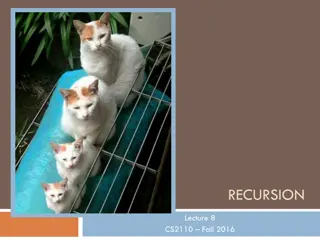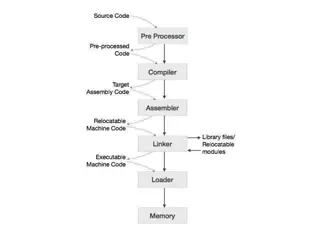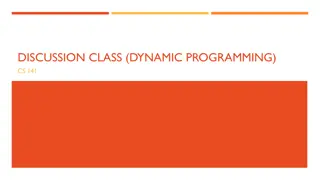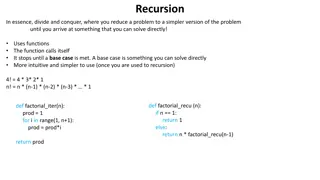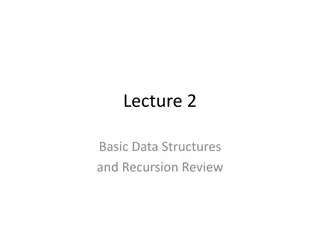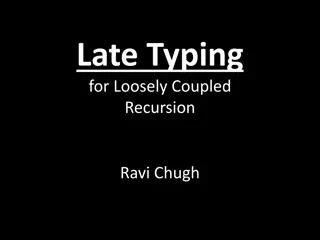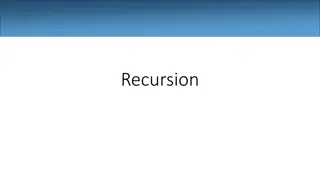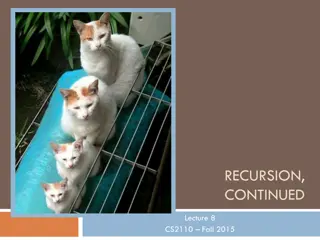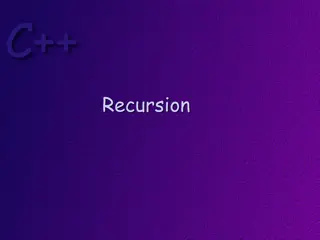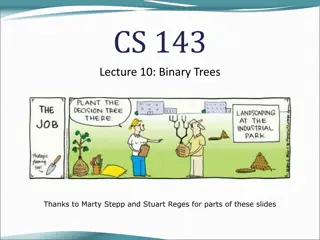Exploring Recursion in Computer Science
Exploring the concept of recursion in computer science, this chapter delves into its applications, advantages, and efficiency. From understanding recursive helper methods to analyzing problems suited for recursive solutions, this chapter covers the fundamental principles of recursion using examples like calculating triangle numbers. Through practical code snippets and explanations, readers will gain insights into how recursion can be a powerful tool in problem-solving and data processing with recursive structures.
Download Presentation

Please find below an Image/Link to download the presentation.
The content on the website is provided AS IS for your information and personal use only. It may not be sold, licensed, or shared on other websites without obtaining consent from the author. Download presentation by click this link. If you encounter any issues during the download, it is possible that the publisher has removed the file from their server.
E N D
Presentation Transcript
Chapter Goals To learn to thinkrecursively To be able to use recursive helper methods To understand the relationship between recursion and iteration To understand when the use of recursion affects the efficiency of an algorithm To analyze problems that are much easier to solve by recursion than by iteration To process data with recursive structures using mutual recursion
Triangle Numbers Recursion: the same computationoccurs repeatedly. Using the same method as the one in this section, you can compute the volume of a Mayan pyramid. Problem: to compute the area of a triangle of width n Assume each []square has an area of 1
Also called the nth triangle number The third triangle number is 6 [] [][] [][][]
Outline of Triangle Class public class Triangle { private int width; public Triangle(int aWidth) { width = aWidth; } public int getArea() { . . . } }
Handling Triangle of Width 1 The triangle consists of a single square. Its area is 1. Add the code to getArea method for width 1: public int getArea() { if (width == 1) { return 1; } . . . }
Handling the General Case Assume we know the area of the smaller, colored triangle: [] [][] [][][] [][][][] Area of larger triangle can be calculated as: smallerArea + width To get the area of the smaller triangle: Make a smaller triangle and ask it for its area: Triangle smallerTriangle = new Triangle(width - 1); int smallerArea = smallerTriangle.getArea();
Completed get Area Method public int getArea() { if (width == 1) { return 1; } Triangle smallerTriangle = new Triangle(width - 1); int smallerArea = smallerTriangle.getArea(); return smallerArea + width; } A recursive computation solves a problem by using the solution to the same problem with simpler inputs.
Computing the area of a triangle with width 4 getArea method makes a smaller triangle of width 3 It calls getArea on that triangle That method makes a smaller triangle of width 2 It calls getArea on that triangle That method makes a smaller triangle of width 1 It calls getArea on that triangle That method returns1 The method returns smallerArea + width = 1 + 2 = 3 The method returns smallerArea + width = 3 + 3 = 6 The method returns smallerArea + width = 6 + 4 = 10
Recursion A recursive computation solves a problem by using the solution of the same problem with simpler values. Two key requirements for successful recursion: Every recursive call must simplify the computation in some way There must be special cases to handle the simplest computations directly To complete our Triangle example, we must handle width <= 0: if (width <= 0) return 0;
Other Ways to Compute Triangle Numbers The area of a triangle equals the sum: 1 + 2 + 3 + . . . + width Using a simple loop: double area = 0; for (int i = 1; i <= width; i++) area = area + i; Using math: 1 + 2 + . . . + n = n (n + 1)/2 => area = width * (width + 1) / 2
section_1/Triangle.java 1 2 3 4 5 6 7 8 /** A triangular shape composed of stacked unit squares like this: [] [][] [][][] . .. */ public class Triangle
section_1/TriangleTester.java public class TriangleTester { public static void main(String[] args) { Triangle t = new Triangle(10); int area = t.getArea(); System.out.println("Area: " + area); System.out.println("Expected: 55"); } ProgramRun: 1 2 3 4 5 6 7 8 9 Area: 55 Expected: 55
Self Check 13.1 Why is the statement else if (width == 1) { return 1; } in the getArea method unnecessary? Answer: Suppose we omit the statement. When computing the area of a triangle with width 1, we compute the area of the triangle with width 0 as 0, and then add 1, to arrive at the correct area.
Self Check 13.2 How would you modify the program to recursively compute the area of a square? Answer: You would compute the smaller area recursively, then return smallerArea + width + width - 1. [][][][] [][][][] [][][][] [][][][] Of course, it would be simpler to compute the area simply as width * width. The results are identical because
Self Check 13.3 In some cultures, numbers containing the digit 8 are lucky numbers. What is wrong with the following method that tries to test whether a number is lucky? public static boolean isLucky(int number) { int lastDigit = number % 10; if (lastDigit == 8) { return true; } else { return isLucky(number / 10); // Test the number without the last digit } } Answer: There is no provision for stopping the recursion. When a number < 10 isn t 8, then the method should return false and stop.
Self Check 13.4 In order to compute a power of two, you can take the next-lower power and double it. For example, if you want to compute 211and you know that 210 = 1024, then 211 = 2 1024 = 2048. Write a recursive method public static int pow2(int n) that is based on this observation. Answer: public static int pow2(int n) { if (n <= 0) { return 1; } // 20 is 1 else { return 2 * pow2(n - 1); } }
Self Check 13.5 Consider the following recursive method: public static int mystery(int n) { if (n <= 0) { return 0; } else { int smaller = n - 1; return mystery(smaller) + n * n; } } What is mystery(4)? Answer: mystery(4) calls mystery(3) mystery(3) calls mystery(2) mystery(2) calls mystery(1) mystery(1) calls mystery(0) mystery(0) returns 0. mystery(1) returns 0 + 1 * 1 = 1 mystery(2) returns 1 + 2 * 2 = 5 mystery(3) returns 5 + 3 * 3 = 14 mystery(4) returns 14 + 4 * 4 = 30
Tracing Through Recursive Methods To debug recursive methods with a debugger, you need to be particularly careful, and watch the call stack to understand which nested call you currently are in.cc
Thinking Recursively Thinking recursively is easy if you can recognize a subtask that is similar to the original task. Problem: test whether a sentence is a palindrome Palindrome: a string that is equal to itself when you reverse all characters A man, a plan, a canal Panama! Go hang a salami, I'm a lasagna hog Madam, I'm Adam
Implement isPalindrome Method: How To 13.1 public class Sentence { private String text; /** Constructs a sentence. @param aText a string containing all characters of the sentence */ public Sentence(String aText) { text = aText; } /** Tests whether this sentence is a palindrome. @return true if this sentence is a palindrome, false otherwise */ public boolean isPalindrome() { . . . } }
Thinking Recursively: How To 13.1 1. Consider various ways to simplify inputs. Here are several possibilities: Remove the first character. Remove the last character. Remove both the first and last characters. Remove a character from the middle. Cut the string into two halves.
Thinking Recursively: How To 13.1 2. Combine solutions with simpler inputs into a solution of the original problem. Most promising simplification: Remove first and last characters adam, I'm Ada, is a palindrome too! Thus, a word is a palindrome if The first and last letters match, and Word obtained by removing the first and last letters is a palindrome What if first or last character is not a letter? Ignore it. If the first and last characters are letters, check whether they match; if so, remove both and test shorter string If last character isn't a letter, remove it and test shorter string If first character isn't a letter, remove it and test shorter string
Thinking Recursively: How To 13.1 3. Find solutions to the simplest inputs. Strings with two characters No special case required; step two still applies Strings with a single character They are palindromes The empty string It is a palindrome
Thinking Recursively: How To 13.1 4. Implement the solution by combining the simple cases and the reductionstep: public boolean isPalindrome() { int length = text.length(); // Separate case for shortest strings. if (length <= 1) { return true; } // Get first and last characters, converted to lowercase. char first = Character.toLowerCase(text.charAt(0)); char last = Character.toLowerCase(text.charAt(length - 1)); if (Character.isLetter(first) && Character.isLetter(last)) { // Both are letters. if (first == last) { // Remove both first and last character. Sentence shorter = new Sentence(text.substring(1, length - 1)); return shorter.isPalindrome(); } else { return false; } } else if (!Character.isLetter(last)) { // Remove last character.
Sentence shorter = new Sentence(text.substring(0, length - 1)); return shorter.isPalindrome(); } else { // Remove first character. Sentence shorter = new Sentence(text.substring(1)); return shorter.isPalindrome(); } }
Recursive Helper Methods Sometimes, a task can be solved by handing it off to a recursive helper method. Sometimes it is easier to find a recursive solution if you make a slight change to the original problem. Consider the palindrome test of previous slide. It is a bit inefficient to construct new Sentence objects in every step Rather than testing whether the sentence is a palindrome, check whether a substring is a palindrome: /** Tests whether a substring of the sentence is a palindrome. @param start the index of the first character of the substring @param end the index of the last character of the substring @return true if the substring is a palindrome */ public boolean isPalindrome(int start, int end)
Recursive Helper Methods: isPalindrome public boolean isPalindrome(int start, int end) { // Separate case for substrings of length 0 and 1. if (start >= end) { return true; } // Get first and last characters, converted to lowercase. char first = Character.toLowerCase(text.charAt(start)); char last = Character.toLowerCase(text.charAt(end)); if (Character.isLetter(first) && Character.isLetter(last)) { if (first == last) { // Test substring that doesn t contain the matching letters. return isPalindrome(start + 1, end - 1); } else { return false; } } else if (!Character.isLetter(last)) { // Test substring that doesn t contain the last character. return isPalindrome(start, end - 1); } else { // Test substring that doesn t contain the first character. return isPalindrome(start + 1, end); } }
Recursive Helper Methods Provide a method to call the helper method with positions that test the entire string: public boolean isPalindrome() { return isPalindrome(0, text.length() - 1); } This call is not recursive The isPalindrome(String) method calls the helper method isPalindrome(String, int, int). An example of overloading The public will call isPalindrome(String) method. isPalindrome(String, int, int) is the recursive helper method.
Self Check 13.6 Do we have to give the same name to both isPalindrome methods? Answer: No the second one could be given a different name such as substringIsPalindrome.
Self Check 13.7 When does the recursive isPalindrome method stop calling itself? Answer: When start >= end, that is, when the investigated string is either empty or has length 1.
Self Check 13.8 To compute the sum of the values in an array, add the first value to the sum of the remaining values, computing recursively. Of course, it would be inefficient to set up an actual array of the remaining values. Which recursive helper method can solve the problem? Answer: A sumHelper(int[] a, int start, int size). The method calls sumHelper(a, start + 1, size).
Self Check 13.9 How can you write a recursive method public static void sum(int[] a) without needing a helper function? Answer: Call sum(a, size - 1) and add the last element,a[size - 1].
The Efficiency of Recursion: Fibonacci Sequence Fibonacci sequence is a sequence of numbers defined by: f1 = 1 f2 = 1 fn = fn-1 + fn-2 First ten terms: 1, 1, 2, 3, 5, 8, 13, 21, 34, 55
section_3/RecursiveFib.java 1 2 3 4 5 6 7 8 9 import java.util.Scanner; /** This program computes Fibonacci numbers using a recursive method. */ public class RecursiveFib { public static void main(String[] args) { ProgramRun: Enter n: 50 fib(1) = 1 fib(2) = 1 fib(3) = 2 fib(4) = 3 fib(5) = 5 fib(6) = 8 fib(7) = 13 . . . fib(50) = 12586269025
The Efficiency of Recursion Recursive implementation of fib is straightforward. Watch the output closely as you run the test program. First few calls to fib are quite fast. For larger values, the program pauses an amazingly long time between outputs. To find out the problem, lets insert trace messages.
section_3/RecursiveFibTracer.java 1 2 3 4 5 6 7 8 9 import java.util.Scanner; /** This program prints trace messages that show how often the recursive method for computing Fibonacci numbers calls itself. */ public class RecursiveFibTracer { public static void main(String[] args) ProgramRun: Enter n: 6 Entering fib: n = 6 Entering fib: n = 5 Entering fib: n = 4 Entering fib: n = 3 Entering fib: n = 2 Exiting fib: n = 2 return value = 1 Entering fib: n = 1 Exiting fib: n = 1 return value = 1 Exiting fib: n = 3 return value = 2 Entering fib: n = 2 Exiting fib: n = 2 return value = 1 Exiting fib: n = 4 return value = 3 Entering fib: n = 3
Entering fib: n = 2 Exiting fib: n = 2 return value = 1 Entering fib: n = 1 Exiting fib: n = 1 return value = 1 Exiting fib: n = 3 return value = 2 Exiting fib: n = 5 return value = 5 Entering fib: n = 4 Entering fib: n = 3 Entering fib: n = 2 Exiting fib: n = 2 return value = 1 Entering fib: n = 1 Exiting fib: n = 1 return value = 1 Exiting fib: n = 3 return value = 2 Entering fib: n = 2 Exiting fib: n = 2 return value = 1 Exiting fib: n = 4 return value = 3 Exiting fib: n = 6 return value = 8 fib(6) = 8
Call Tree for Computing fib(6) Figure 2 Call Pattern of the Recursive fib Method
The Efficiency of Recursion Method takes so long because it computes the same values over and over. The computation of fib(6) calls fib(3) three times. Imitate the pencil-and-paper process to avoid computing the values more than once.
section_3/LoopFib.java 1 2 3 4 5 6 7 8 9 import java.util.Scanner; /** This program computes Fibonacci numbers using an iterative method. */ public class LoopFib { public static void main(String[] args) { ProgramRun: Enter n: 50 fib(1) = 1 fib(2) = 1 fib(3) = 2 fib(4) = 3 fib(5) = 5 fib(6) = 8 fib(7) = 13 . . . fib(50) = 12586269025
The Efficiency of Recursion In most cases, the iterative and recursive approaches have comparableefficiency. Occasionally, a recursive solution runsmuch slower than its iterative counterpart. In most cases, the recursive solution is only slightly slower. The iterative isPalindromeperforms only slightly better than recursive solution. Each recursive method call takes a certain amount of processor time Smart compilers can avoid recursive method calls if they follow simple patterns. Most compilers don't do that. In many cases, a recursive solution is easier to understand and implement correctly than an iterative solution.
Iterative is Palindrome Method public boolean isPalindrome() { int start = 0; int end = text.length() - 1; while (start < end) { char first = Character.toLowerCase(text.charAt(start)); char last = Character.toLowerCase(text.charAt(end); if (Character.isLetter(first) && Character.isLetter(last)) { // Both are letters. if (first == last) { start++; end--; } else { return false; } } if (!Character.isLetter(last)) { end--; } if (!Character.isLetter(first)) { start++; } } return true; }
Self Check 13.10 Is it faster to compute the triangle numbers recursively, as shown in Section 13.1, or is it faster to use a loop that computes 1 + 2 + 3 + . . . + width? Answer: The loop is slightly faster. Of course, it is even faster to simply compute width * (width + 1) / 2.
Self Check 13.11 You can compute the factorial function either with a loop, using the definition that n! = 1 2 . . . n, or recursively, using the definition that 0! = 1 and n! = (n 1)! n. Is the recursive approach inefficient in thiscase? Answer: No, the recursive solution is about as efficient as the iterative approach. Both require n 1 multiplications to compute n!.
Self Check 13.12 To compute the sum of the values in an array, you can split the array in the middle, recursively compute the sums of the halves, and add the results. Compare the performance of this algorithm with that of a loop that adds the values. Answer: The recursive algorithm performs about as well as the loop. Unlike the recursive Fibonacci algorithm, this algorithm doesn t call itself again on the same input. For example, the sum of the array 1 4 9 16 25 36 49 64 is computed as the sum of 1 4 9 16 and 25 36 49 64, then as the sums of 1 4, 9 16, 25 36, and 49 64, which can be computed directly.
Permutations Using recursion, you can find all arrangements of a set of objects. Design a class that will list all permutations of a string. A permutation is a rearrangement of the letters. The string "eat" has six permutations: "eat" "eta" "aet" "ate" "tea" "tae"
Permutations Problem: Generate all the permutations of "eat". First generate all permutations that start with the letter 'e', then 'a' then 't'. How do we generate the permutations that start with 'e'? We need to know the permutations of the substring "at". But that s the same problem to generate all permutations with a simpler input Prepend the letter 'e' to all the permutations you found of 'at'. Do the same for 'a' and 't'. Provide a special case for the simplest strings. The simplest string is the empty string, which has a single permutation itself.
section_4/Permutations.java 1 2 3 4 5 6 7 8 9 import java.util.ArrayList; /** This program computes permutations of a string. */ public class Permutations { public static void main(String[] args) { ProgramRun: eat eta aet ate tea tae
Self Check 13.13 What are all permutations of the four-letter word beat? Answer: They are b followed by the six permutations of eat, e followed by the six permutations of bat, a followed by the six permutations of bet, and t followed by the six permutations of bea.
